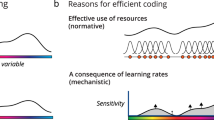Abstract.
The nervous system uses two basic types of formats for encoding information. The parameters of many sensory (and some premotor) signals are represented by the pattern of activity among an array of neurons each of which is optimally responsive to a different parameter value. This type of code is commonly referred to as a place code. Motor commands, in contrast, use rate coding: the desired force of a muscle is specified as a monotonic function of the aggregate rate of discharge across all of its motor neurons. Generating movements based on sensory information often requires converting signals from a place code to a rate code. In this paper I discuss three possible models for how the brain does this.
Similar content being viewed by others
Author information
Authors and Affiliations
Additional information
Received: 24 July 2000 / Accepted in revised form: 2 February 2001
Rights and permissions
About this article
Cite this article
Groh, J. Converting neural signals from place codes to rate codes. Biol Cybern 85, 159–165 (2001). https://doi.org/10.1007/s004220100249
Issue Date:
DOI: https://doi.org/10.1007/s004220100249




